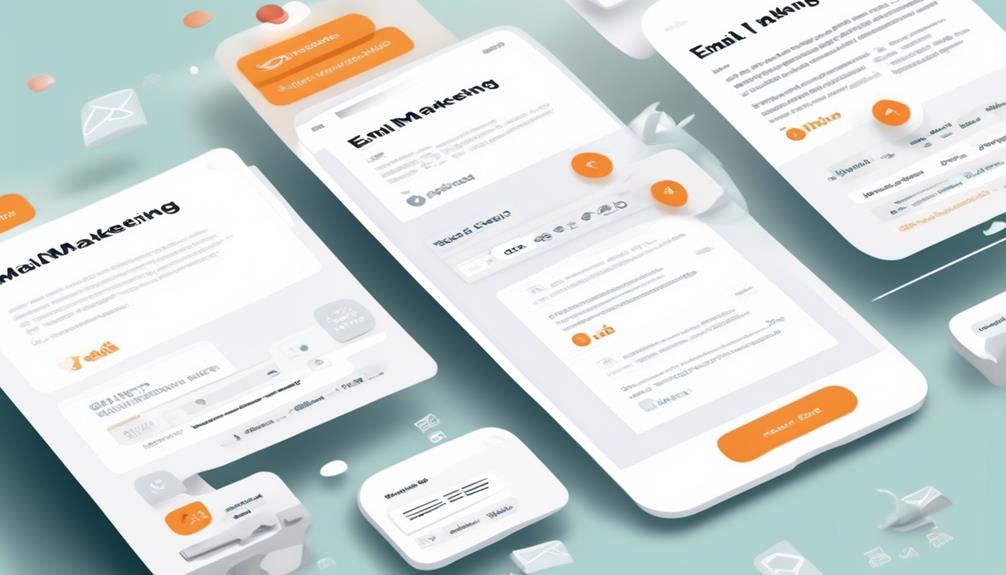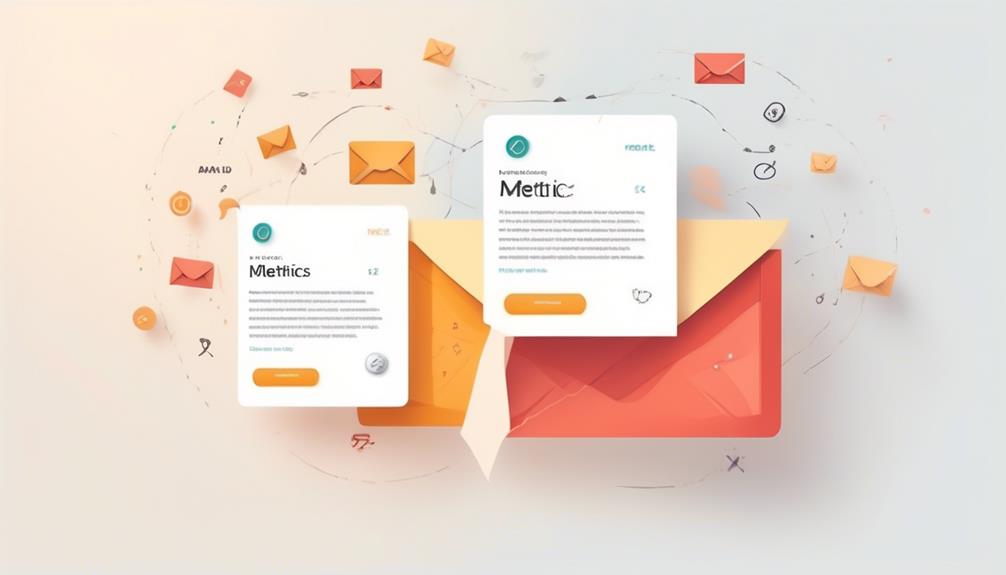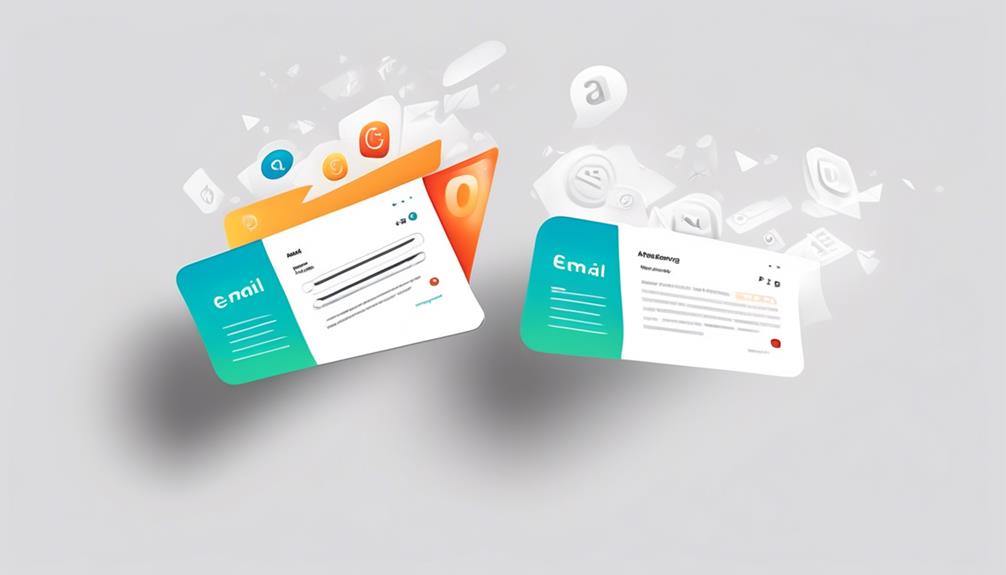In a world where a slight change in a sail’s direction can determine whether a ship catches the wind, the same applies to making small adjustments to email communication that can impact the success of a marketing campaign. As marketers, we navigate through the ever-changing landscape of consumer preferences and engagement.
It's no secret that A/B testing is our compass, guiding us toward the most effective strategies. But what makes for truly effective email A/B testing? How do we ensure that our efforts yield meaningful results and drive success?
Let's explore the 10 best practices that can steer our email campaigns in the right direction, helping us to navigate the ever-changing tides of consumer behavior and preferences.
Key Takeaways
- Isolate test variables and use control versions to accurately measure the impact of changes.
- Conduct simultaneous testing to compare the performance of different elements and strategies.
- Check for statistical significance to ensure reliable and valid results from A/B tests.
- Continuously challenge and optimize email campaigns based on insights gained from testing to improve effectiveness.
Isolate Test Variables
In A/B testing, it's crucial to isolate test variables by changing only one element at a time to accurately measure its impact on email performance. This method allows for a systematic and methodical approach to understanding the individual impact of each variable on email performance.
By isolating variables, we can determine the effectiveness of specific elements without confounding factors, ensuring that the results of A/B testing are reliable and actionable.
Isolating test variables in email testing is essential for gaining insights into the performance of different elements within the email, such as subject lines, call-to-action buttons, or content layout. It provides a clear understanding of how each element contributes to the overall performance of the email, enabling informed decision-making for optimization.
This approach helps in comprehensively optimizing email campaign elements, as it enables us to pinpoint the exact impact of each variable at a time.
Ultimately, isolating test variables is fundamental for conducting effective A/B testing and enhancing the overall performance of email campaigns.
Use Control Versions
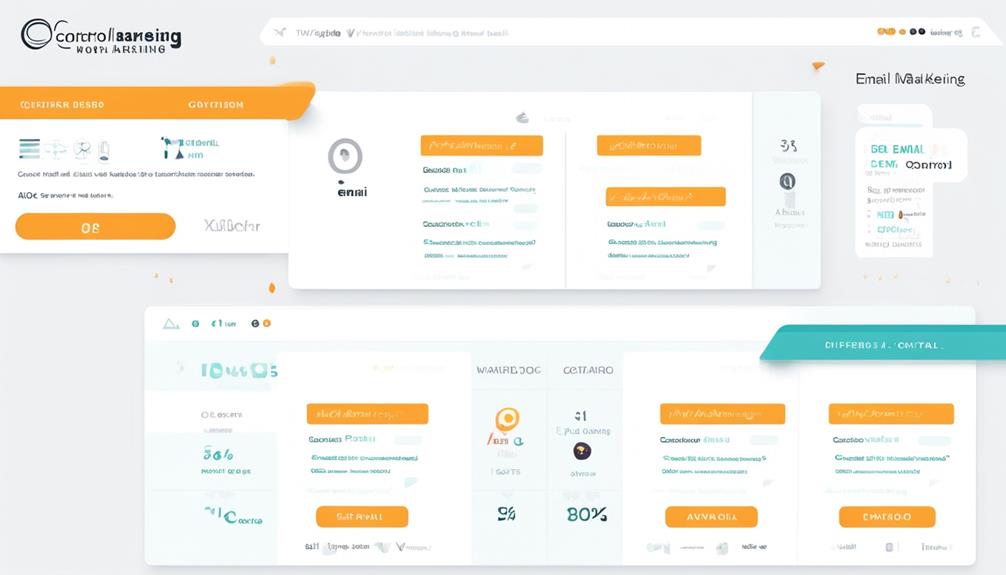
We typically use a control version to compare results and establish a baseline for evaluating the effectiveness of changes made in the test variations. A/B testing email helps in accurately measuring the impact of changes made in the test variants. The control version serves as a reference point for evaluating the effectiveness of changes made in the test variations. It enables us to understand the relative performance of the tested elements. Using a control version allows for a direct comparison of the impact of specific elements on email performance.
| Control Version | Test Variation 1 | Test Variation 2 |
|---|---|---|
| Subject Line A | Subject Line B | Subject Line C |
| Call to Action X | Call to Action Y | Call to Action Z |
| Image 1 | Image 2 | Image 3 |
| Personalization A | Personalization B | Personalization C |
Simultaneous Testing
How can simultaneous testing improve the efficiency and accuracy of evaluating multiple email variations?
Simultaneous testing allows for the comparison of multiple email variations at the same time, providing quicker and more efficient insights into their performance. This approach is essential for obtaining accurate and reliable results when comparing different email versions.
By testing simultaneously, the impact of external factors such as seasonality or changes in customer behavior can be reduced, leading to a more accurate assessment of the email marketing strategies. Moreover, simultaneous testing is particularly useful for comparing the impact of multiple variables on email performance, enabling marketers to optimize their campaigns for higher open rates and engagement.
In the context of A/B testing, the use of simultaneous testing can significantly enhance the speed and precision of decision-making. Marketers can swiftly gather data on the performance of different email elements and make informed choices based on the results.
As a result, simultaneous testing offers a data-driven and analytical approach to refining email marketing strategies, ultimately leading to improved open rates and overall campaign effectiveness.
Check Statistical Significance

To ensure the validity of the A/B test outcomes and make informed decisions about email performance, checking statistical significance is crucial. Statistical significance helps determine if the observed differences between email variants are likely not due to random chance, allowing for confident conclusions about which variant performs better.
Here are three essential steps to check statistical significance in A/B testing:
- Understand the Concept: Gain a solid understanding of statistical significance to accurately interpret A/B test results. This involves learning how to calculate statistical significance and comprehend its implications for email performance.
- Utilize Statistical Tools: Utilize statistical tools and software to calculate the statistical significance of the A/B test results accurately. These tools can help in determining the probability that the observed differences are due to the changes made in the test, rather than random fluctuations.
- Avoid Drawing Incorrect Conclusions: Be mindful of the potential pitfalls of misinterpreting A/B test results. Knowing how to check statistical significance ensures that any observed differences in email performance are likely due to the changes implemented in the test, rather than chance.
Continuously Challenge Through Tests
We continuously challenge our email marketing strategies through A/B tests to optimize our campaigns.
By testing different elements and analyzing the results, we can implement winning changes that improve our email performance.
This ongoing experimentation allows us to refine and enhance our email marketing efforts for better results.
Test Different Elements
Incorporate continuous testing of various elements, including subject lines, visuals, and call-to-action buttons, to refine and optimize email performance.
When testing different elements in email marketing, it's essential to focus on the following:
- Subject Lines: Experiment with varying lengths, tones, and personalization to determine the most effective approach for engaging recipients and boosting open rates.
- Visuals: Test different types of imagery, colors, and layouts to assess their impact on click-through rates and overall engagement.
- Call-to-Action Buttons: Try different wording, colors, and placements to pinpoint the most compelling calls to action that drive conversions.
Analyze Test Results
With each test, we continually challenge and analyze the results to refine and optimize our email marketing strategy. Analyzing test results is crucial for understanding the impact of changes and making data-driven decisions.
By regularly analyzing the outcomes of A/B tests, we can uncover valuable insights into what resonates with our audience and drives engagement. It's essential to delve into the data to identify patterns, trends, and areas for improvement.
Through rigorous analysis of test results, we gain a deeper understanding of our subscribers' preferences and behaviors, enabling us to tailor our email content more effectively.
Continuously challenging our assumptions and testing new ideas allows us to refine and enhance our email marketing strategy based on concrete data and results. This iterative process of analysis and refinement is fundamental to ongoing success in email marketing.
Implement Winning Changes
To continuously optimize different aspects of your emails, regularly challenge through new tests and implement winning changes based on the most effective elements identified through A/B testing. Implementing winning changes is crucial to improving your campaign's performance.
Here are three key steps to achieve this:
- Analyze A/B test results thoroughly to identify the winning elements that significantly impact email performance.
- Implement the successful elements into your email content, design, or subject lines to enhance overall effectiveness.
- Continuously challenge and refine your email content through A/B testing to ensure optimal performance and consistently improve your campaign.
Test Across Email Clients

Testing email rendering across various email clients ensures consistent display and optimal user experience. A/B testing in email marketing should include checking the rendering of emails in popular email clients such as Gmail, Outlook, and Apple Mail. By doing so, we can ensure that our email content is optimized for all recipients, regardless of the platform or device they use.
It's important to ensure that emails are displayed correctly and consistently across different email platforms and devices to provide a seamless experience for our audience.
Prioritizing email client testing allows us to identify any potential rendering issues and make necessary adjustments to improve the overall user experience. This data-driven approach ensures that our emails aren't only visually appealing but also functional across a wide range of email clients.
Define Audience

When conducting A/B testing for email campaigns, it's essential to define our target audience with precision. By segmenting the audience based on demographics, behavior, and interests, we can create control and test groups for accurate testing.
Factors like age, gender, location, and past interactions play a crucial role in ensuring that our test groups represent our overall subscriber base.
Target Audience
Understanding the demographics, interests, and behaviors of our target audience is crucial for accurate A/B testing of email content.
To effectively define our target audience, we should:
- Segment our audience: Randomly segmenting our audience creates diverse test groups representative of our overall subscriber base, allowing for more accurate A/B testing.
- Consider audience goals: Identifying the goals and preferences of our audience justifies variations in our email content and ensures that our campaigns are tailored to their needs.
- Test audience response: Measuring audience reactions to different offers or incentives helps determine their preferences and allows for informed decision-making in our email campaigns.
Audience Segmentation
To achieve accurate A/B testing of email content, defining our audience through strategic segmentation based on demographics, behavior, and preferences is essential. Audience segmentation allows us to tailor email content to specific segments, gaining insights into what resonates with different groups. By segmenting our audience randomly, we ensure unbiased testing and accurate insights. Implementing audience segmentation enables us to understand how different elements of our emails perform with specific subsets of our audience, leading to more personalized and targeted email campaigns. This approach is crucial for improving email open rates and overall campaign effectiveness. Below is a visual representation of the potential audience segmentation factors:
| Demographics | Behavior | Preferences |
|---|---|---|
| Age | Purchase history | Content format preferences |
| Gender | Website interactions | Product interests |
| Location | Email engagement | Frequency of communication |
Identify Goals and Justify Variation
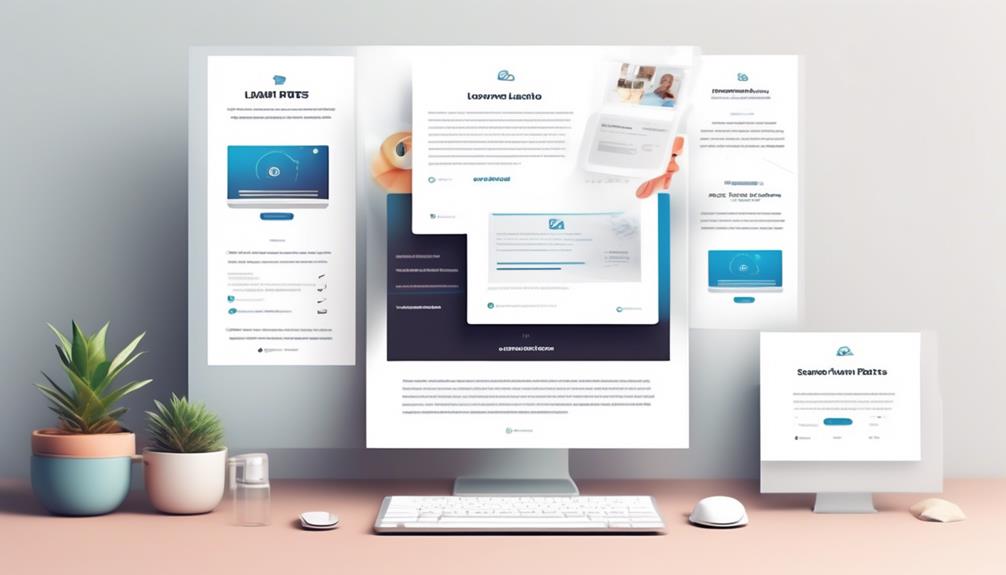
In identifying our goals and justifying variations for A/B testing, it's crucial to clearly define the specific email marketing objectives we aim to achieve. This ensures that our A/B testing efforts are aligned with our broader email marketing strategy and contribute to improving our overall email performance.
Here's how we can effectively identify goals and justify variations for A/B testing:
- Align variations with specific email marketing objectives: Every variation we introduce in our A/B tests should be tied to a clearly defined email marketing objective. Whether it's to improve open rates, click-through rates, or conversion rates, each variation should serve a specific purpose in advancing our email marketing goals.
- Justify variations based on audience preferences and behaviors: Before implementing variations, we need to consider how they align with our audience's preferences and behaviors. Understanding our audience's needs and preferences will help us justify the variations we test and ensure that they resonate with our subscribers.
- Evaluate variations against predefined goals: It's essential to evaluate whether the variations in our A/B tests will contribute to improved email performance based on our predefined goals. This ensures that our testing efforts are focused on delivering tangible improvements that align with our email marketing strategy.
Proper Data Management

Proper data management is essential for ensuring the accuracy and reliability of A/B test results, aligning with our goals and justifying variations in our email marketing strategy. To achieve this, we must organize and store our data in a structured manner that allows for easy access and analysis for testing purposes.
It's crucial to regularly clean and update our data to maintain its quality and integrity, ensuring that our A/B testing is based on accurate information. Documenting and tracking our data management processes is also essential to guarantee consistency and transparency in our testing procedures.
Additionally, implementing robust data security measures is imperative to protect the confidentiality and privacy of our testing data, safeguarding it from unauthorized access or breaches.
Furthermore, when conducting A/B testing in email marketing, it's vital to ensure that the sample size is large enough to yield statistically significant results. By managing our data effectively, we can make informed decisions based on reliable insights derived from split testing, ultimately enhancing the effectiveness of our email marketing strategies.
Be Patient

Let's discuss the importance of being patient when conducting A/B tests.
It's crucial to allow the tests to run until statistical significance is achieved, ensuring accurate and reliable insights.
Test Variable Elements
With variable elements testing, patience is crucial for obtaining accurate and actionable results. When conducting A/B testing for email marketing campaigns, it's important to allow tests to run until statistical significance is achieved. Making changes to live tests should be avoided to maintain data integrity.
Patience is key – allowing data to flow in for actionable analysis before drawing conclusions is essential. Properly storing information for future reference and analysis is also vital. Rushing the testing process should be avoided, as accurate results require time and patience.
For instance, when testing different subject lines, it's important to give each variation enough time to gather sufficient data for meaningful analysis.
Analyze Results Carefully
When analyzing A/B testing results, patience and thoroughness are essential for obtaining reliable and actionable insights. It's crucial to allow tests to run until statistical significance is achieved, ensuring that the data collected accurately reflects the performance of the tested variables. Rushing the process can lead to inaccurate conclusions and decisions.
Avoid making changes to live tests and allow data to flow in for actionable analysis. Properly storing information for future reference is crucial for analyzing results carefully. This includes documenting the variables tested, the duration of the test, and the open and click-through rates observed.
Patience is key in A/B testing your emails to ensure accurate and reliable results, enabling you to make informed decisions based on robust data.
Adjust Strategy as Needed
To optimize email performance, it's imperative to patiently assess A/B testing results until statistical significance is achieved before considering any adjustments to your strategy.
When it comes to adjusting strategy as needed in A/B testing, we should:
- Avoid making changes to live tests and allow data to flow in for actionable analysis.
- Properly store information for future reference and continuously challenge through new tests to optimize different aspects of your emails.
- Understand the importance of statistical significance before implementing changes into your strategy.
What Are Some Additional Best Practices for Email A/B Testing Beyond the Key Tips Provided?
When it comes to tips for email testing, additional best practices for A/B testing include segmenting the audience based on behavior, testing different subject lines, personalizing content, testing various send times, and analyzing results to make data-driven decisions. These strategies can further enhance the effectiveness of email marketing efforts.
Frequently Asked Questions
How to Do Ab Testing for Emails?
We conduct A/B testing for emails by sending two versions of emails to separate groups to determine effectiveness.
We test variables like subject lines, personalization, images, call-to-action, and timing for optimization.
Isolate test variables, use a control version, test simultaneously, ensure statistical significance, and continuously challenge through new tests.
Implement across email clients, define audience, justify content variations, manage data, and analyze for continuous improvement.
Importance lies in patience, gathering feedback, and understanding benefits.
Which of the Following Are Best Practices in a B Testing?
We nail down the best A/B testing practices by:
- Isolating test variables
- Using a control version
- Testing simultaneously to account for changes in customer behavior
We ensure statistical significance and continuously challenge through new tests to optimize our email campaigns.
Why Is It Important to Ab Test for Emails?
It's important to A/B test for emails because it allows us to make data-driven decisions and identify the most effective strategies for improved engagement and conversions.
By testing small changes, we can significantly impact open and click-through rates, ultimately increasing revenue.
With the high volume of daily emails, A/B testing is crucial for grabbing recipients' attention and effectively converting them.
This empirical approach leads to better performance and increased engagement.
What Are Some Best Practices for the Use of a B Testing Within an Organization?
We always prioritize A/B testing to optimize our strategies. Isolating test variables accurately assesses effectiveness. Using a control version establishes a baseline for comparison. Simultaneously testing variables accounts for seasonal and behavioral changes. We ensure statistical significance before implementing changes.
Continuous testing challenges optimize email aspects. This data-driven approach consistently enhances our email marketing strategy.
Conclusion
In the world of email A/B testing, the only constant is change. We may think we've found the perfect formula, but the data always has a surprise in store for us.
So, let's embrace the irony of constantly challenging our assumptions, isolating variables, and seeking statistical significance. With patience and proper data management, we can uncover the winning combination that drives effective email marketing.
Keep testing, keep learning, and keep adapting.
